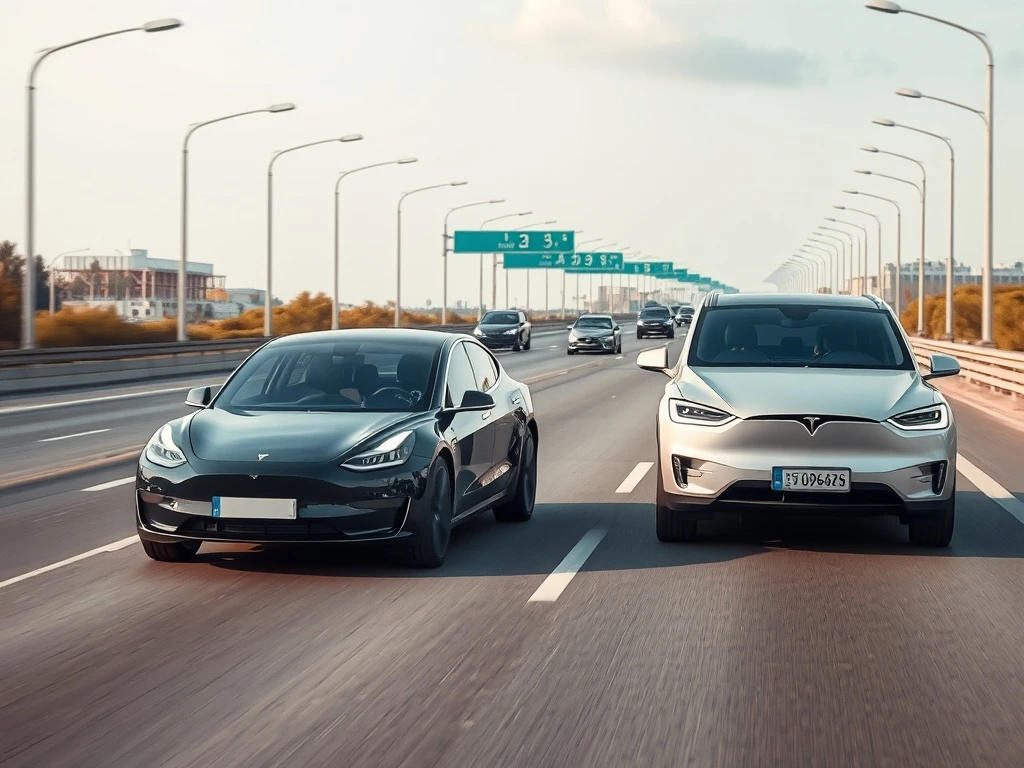Tesla FSD Triumphs: Dominating Chinese EV Safety Tests with Unrivaled Driver-Assist Technology

In the rapidly evolving landscape of automotive technology, where innovation meets the open road, a recent development has sent ripples through the global electric vehicle (EV) sector. For those closely watching the intersection of cutting-edge AI and market dynamics, particularly within the cryptocurrency space where technological advancements often dictate investment trends, a significant benchmark has been set. Tesla’s Full Self-Driving (FSD) system has not only participated but remarkably outperformed 35 Chinese EVs in a rigorous highway safety evaluation. This achievement isn’t just a win for Tesla; it underscores the critical role of advanced AI in shaping the future of transportation and, by extension, influencing broader tech-driven economies.
Tesla FSD Sets a New Benchmark in Highway Safety
A comprehensive test conducted by Dcar (ByteDance’s automotive division) and China’s state broadcaster CCTV recently put Level 2 driver-assist technologies through their paces. The results were clear: Tesla’s Model 3 and Model X, equipped with the latest Tesla Hardware 4.0 platform, emerged as the top performers among 36 participants. These vehicles successfully navigated five out of six simulated high-risk scenarios on expressways and urban roads, showcasing the prowess of Tesla FSD.
- Top Performance: Tesla Model 3 and Model X successfully completed 5 out of 6 test conditions.
- Hardware Advantage: Tesla’s Hardware 4.0 platform played a crucial role in its superior integration of software and hardware.
- Key Competitors: BYD’s Denza Z9GT and Huawei-supported Aito M9 each failed three challenges, while Xiaomi’s SU7 cleared only one.
This remarkable performance has ignited extensive discussion on Chinese social media, with some questioning the testing methodology. However, the underlying message is undeniable: Tesla’s holistic approach to autonomous driving, emphasizing deep hardware-software integration, yields tangible safety benefits.
The Quandary of Global Data vs. Local Adaptability for Tesla FSD
Elon Musk, CEO of Tesla, attributed the company’s success to its global data-driven approach. This statement highlights a unique challenge Tesla faces in China. Due to strict Chinese regulations against data export, Tesla is unable to transfer data collected from its vehicles in China back to the U.S. for AI training. Musk described this situation as a “quandary,” noting that despite having no local training data from China, Tesla achieved top results.
This paradox underscores the adaptability of Tesla’s algorithms to complex environments, even without China-specific road condition training. It suggests that a robust, globally-trained AI model can still translate effectively to diverse local scenarios, a testament to the system’s underlying intelligence. However, the long-term competitive landscape for driver-assist technology will increasingly demand localized data to fine-tune systems for unique road networks and driving behaviors.
Navigating the Competitive Landscape of Chinese EVs
While Tesla celebrates its test victory, China’s EV industry is not standing still. Domestic brands like BYD, Xiaomi, and those supported by tech giants like Huawei, are making rapid strides in developing their own driver-assist technology. The market is fiercely competitive, with Chinese manufacturers leveraging their understanding of local road networks and consumer preferences.
Industry experts, including Wang Yao of the China Association of Automobile Manufacturers, acknowledge that local firms still trail Tesla in core capabilities such as multi-lane highway navigation and pedestrian detection. However, they are quickly closing the gap through:
- Accelerated AI-driven Innovations: Significant investment in R&D for AI and autonomous driving.
- Strategic Partnerships: Collaborations with leading tech firms like Huawei to integrate advanced software and hardware solutions.
- Local Data Advantage: The ability to collect and process vast amounts of localized data for algorithm refinement, a critical long-term advantage over Tesla in China.
Despite Tesla’s current lead, Chinese brands like BYD have already surpassed Tesla in annual sales, and Xiaomi’s latest SU7 has seen strong initial demand, indicating the resilience and growing appeal of domestic options in the EV Market China.
Heightened Scrutiny on Autonomous Driving Safety
The Dcar/CCTV test coincided with a period of heightened scrutiny on autonomous driving safety in China. A tragic Xiaomi SU7 crash in March, which resulted in three fatalities, prompted immediate regulatory responses. Regulators have since banned marketing terms like “smart driving” and “autonomous driving,” preferring more cautious labels for Level 2 systems.
Furthermore, the public security ministry clarified legal responsibilities for Level 2 systems, emphasizing that drivers retain ultimate control and warning against overreliance on semi-autonomous features. These measures reflect broader concerns about consumer expectations and the imperative for robust safety standards as driver-assist technology becomes more prevalent. Recent studies show that these systems are now the most in-demand feature in EV purchases, underscoring the public’s growing interest alongside regulatory caution.
What’s Next for the EV Market China and Global Autonomous Driving?
Tesla’s impressive performance in this safety test has undoubtedly bolstered investor confidence, with stock prices reflecting the positive sentiment. However, the company operates in a fiercely competitive environment where Chinese EV producers are accelerating their AI-driven innovations to close the gap.
The test results underscore several key dynamics:
- Tesla’s Global Data Edge: Currently provides a significant performance advantage.
- Importance of Localized Adaptability: Local competitors are leveraging their understanding of domestic road networks to refine their systems, a critical factor for future success.
- Regulatory Landscape: The need for companies like Tesla to gain regulatory approval for transferring Chinese data for algorithm training will be crucial for maintaining their lead and further enhancing their systems for the Chinese market.
For now, Tesla’s Full Self-Driving system stands as a benchmark in driver-assist technology, even as the global innovation race in the EV sector intensifies. The ongoing competition promises rapid advancements, ultimately benefiting consumers with safer and more sophisticated driving experiences.
Conclusion
Tesla’s dominant performance in the recent highway safety test against 35 Chinese EVs is a powerful testament to the maturity and effectiveness of its FSD system. This victory, achieved despite significant data export restrictions, highlights Tesla’s technological prowess and its foundational role in advancing autonomous driving. As the EV Market China continues its explosive growth, driven by both domestic innovation and international competition, the focus on safety and advanced driver-assist technology will only intensify. While Tesla currently holds a significant lead, the rapid advancements by Chinese manufacturers, coupled with evolving regulatory landscapes, promise a dynamic future where localized adaptability and continuous innovation will be key to long-term success. This competitive drive will ultimately push the boundaries of what’s possible in self-driving, making roads safer and commutes smarter for everyone.
Frequently Asked Questions (FAQs)
Q1: What was the main finding of the Dcar/CCTV highway safety test?
The test found that Tesla’s Full Self-Driving (FSD) system, specifically in its Model 3 and Model X vehicles, significantly outperformed 35 Chinese EV competitors in simulated high-risk highway and urban road scenarios, successfully completing five out of six challenges.
Q2: How did Tesla FSD perform so well despite data export restrictions in China?
Elon Musk attributed Tesla’s success to its global data-driven approach. Despite not being able to export data collected in China for AI training, Tesla’s globally trained algorithms demonstrated remarkable adaptability and robustness in the complex Chinese road environment, showcasing the strength of its core technology.
Q3: What challenges do Chinese EV manufacturers face in competing with Tesla’s driver-assist technology?
While Chinese EV makers are rapidly advancing, industry experts note they still trail Tesla in core capabilities like multi-lane highway navigation and advanced pedestrian detection. Their main challenges include catching up in deep hardware-software integration and refining their AI models to match Tesla’s proven performance.
Q4: How is China addressing concerns about autonomous driving safety?
Following a recent fatal accident involving a Xiaomi SU7, Chinese regulators have heightened scrutiny on autonomous driving safety. They have banned marketing terms like “smart driving” and “autonomous driving” for Level 2 systems and clarified legal responsibilities, warning drivers against overreliance on semi-autonomous features to ensure safety and manage consumer expectations.
Q5: What is the significance of this test for the broader EV Market China?
This test positions Tesla as a benchmark for driver-assist technology in China, reinforcing its market position and investor confidence. However, it also highlights the intense competition, with Chinese brands accelerating their AI innovations and leveraging localized data to close the gap, signaling a continued innovation race that will shape the future of the EV market.









